BEAR LAKE UPDATE — Manistee County, Michigan May '20 to Jan '22
 Having dug a pond the year before, we finally worked out a deal for someone to deliver clay and line the pond with it.
Having dug a pond the year before, we finally worked out a deal for someone to deliver clay and line the pond with it.
A good red clay…but not the blue clay I had hoped to locate. They applied 550 yards, about 4-5” thick. If you remember a 3-4” rain in mid-late September—this caused the pond to fill up to a 4’ depth. The joy of that was short-lived as we saw it gradually go down and finally settle at about 12”… then disappear altogether. Not sure if that means that we are going to need twice as much clay…or if it just has to settle, but at a minimum, extra time will be needed (and probably some more $$ this summer).

For deer hunting in 2020, we established a new food plot down in a protected valley. There were blackberries growing there and I disced that about 5 times over the summer before the roots were gone... and the persistent canes finally gave up. I planted it in turnips and soybeans in late August. Soybeans were a waste of money, but the turnips came up great and they were soon discovered and appreciated by the deer. That little honey hole was productive for me as I shot a 9 point with my crossbow and a 5 point with my 30-06. A good return on investment! I think I need to give that spot to my Dad next year. 😊
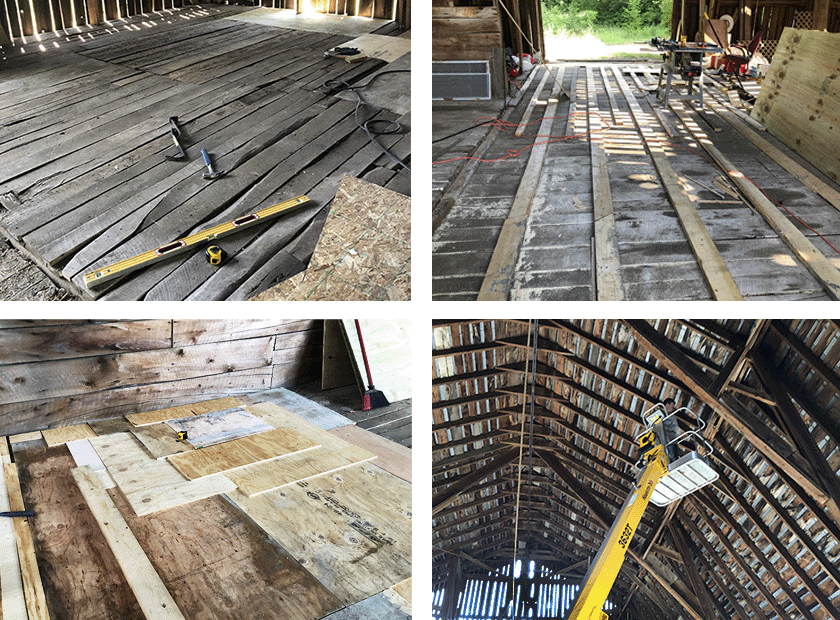
What else? The dog days of summer got us thinking about improvements we could make indoors, so we decided to put a new floor on the main floor of the barn. This became quite an undertaking as the floor varied up to 6” in height due to settling. The supporting timbers were giving way and probably not being built all that level to start with. I cannot tell you how many sheets of plywood we used in that 40 x 60’ barn, but I’m going to guess around 200…Luan board, ½ inch OSB, CDX grade ¾” for underlayment, finish ¾” grade for the surface. Add to that, hundreds of feet of 2x4, 2x6 to fill in the bigger gaps... it was quite an endeavor. But again, persistence is what’s needed and you figure it out as you go. 3 guys working for three 3 weeks was about what it took in labor. We enjoy building and transforming the barn into a safe place again; there were a lot of holes caused by leaks in the roof. The neighbors even used the barn as their wedding venue last fall! At least with the floor improvement the dancing should also be improved!
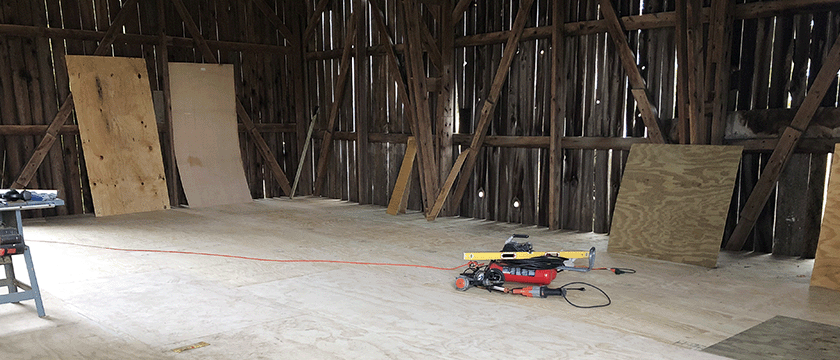
Trimming mature trees: This has taken two forms. The first, motivated primarily to limit the amount of shade spreading over our newly planted areas. A lot of these areas are surrounded by 60-80’ Sugar Maples. They extended out from their trunk up to 35’ over the field. We trimmed back to the trunk and then trimmed up as high as we could, using a tow behind 37’ battery operated hydraulic lift. While we were cutting back those branches, we also could get into the woods to do quality improvement by de-limbing the trees that were off the edge (so I could trim about 30’ off the trail into the woods). Having completed that perimeter work in the summer of 2020, round two came in the fall/winter as we had some available time to work on what I would consider to be “timber improvement”. It didn’t really differ from what I was doing on the edge of the new plantings but the purpose was to create as many clear logs as possible for harvest some 20-40 years down the road.

To do this, I again employed the hydraulic lift and went to work wherever there was access into the woods—two tracks, meadow edges, sometimes cutting out small trees to pull the lift into position. I spent about 5-7 days doing this sort of work. Since I was pulling the lift with a pickup, there was limited access. I expect to do this again in years to come, where I can use a tractor to get into some tighter corners.
While I was doing this, I took two of my guys up and we tested two saws. One, a 20’ extendable manual pole saw manufactured by “Silky”, a Japanese firm; it allowed us to go through the woods and trim up to 25’. We chose better formed trees—mostly sugar maple, some black Cherry and the occasional oak. We skipped Basswood, Beech, Hophornbeam and Elm.
We also tried using a battery powered chain polesaw, which has a very small bar—roughly 8” and extends to about 12’. This purchase has not worked out too well. It doesn’t seem to have the required torque, the battery runs out too soon and the guys who used both said they definitely preferred the Silky manual saw. The manual saw cuts one way, but with about 4 strokes you can cut through a 1” diameter limb. Some complaining about a sore neck, sore arms and general tiredness, so this is a task best assigned to younger workers or best to limit activity to 8 hours a day.
During my final winter trip up in January 2021, I was working with the lift but got it stuck so changed courses and began trimming up well formed trees with the chainsaw, getting ahead of the guys who were working with the extension saws. This worked out well for a couple reasons—first, the guys with the manual saws didn’t need to trim lower branches, which made their work more efficient and secondly, I could tell them to only trim the trees that I had trimmed…thus reducing the time they would need to make decisions themselves.

2021 was a busy year with lots of trips to the property.
Often we need an event to focus our energies and preparation--such was the case with the restoration of the barn…built sometime in the 40s? As mentioned above, we took care of the floor first. The roof was in need of repair, as well as some serious leaks on the south side. The leaks were due to some tearing and also to the sun, making the metal move and elongating the nail holes, which then sometimes fell out. Add to that some rust working through generally and we had a threefold project—replace all loose/missing nails with screws, replace some metal sections altogether, prime and then finish paint. Add a couple sections of gutter over the door openings and you have several intermittent weeks of work for 2-3 people. Not a difficult project in principle, but at its tallest, the roof is 50’ off the ground.… A 45’ lift was rented to complement our 37’ lift…yet both were too limited in reach to get onto the top section of the roof, so we worked with ropes tied to the lifts which were then thrown over to the opposite side to secure workers.
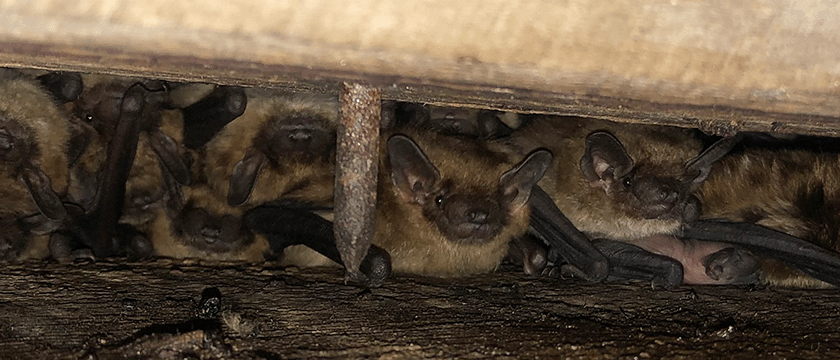 Bats: The bats roosting in the barn gave us fits as they would not leave us alone, leaving fresh poop on the new floor by day…but catching mosquitoes by night. I estimate at least 100 were roosting during the day in the barn. My war with them started by hanging moth ball bags adjacent to where they would roost. Some left, but not all. The poop on the new floor was a pretty easy gauge as to how the battle was going. When that didn’t do trick, and with less than two months remaining before the wedding reception, I changed tactics and started blocking off the roosting area. I left them an opening of 3” to get in/out of where they were roosting…but less poop ending up on the floor as a result. This ultimately did the trick and the pooping party was down to a trickle by mid-September. Eventually, it seems they all have left. We’ll see what next year brings!
Bats: The bats roosting in the barn gave us fits as they would not leave us alone, leaving fresh poop on the new floor by day…but catching mosquitoes by night. I estimate at least 100 were roosting during the day in the barn. My war with them started by hanging moth ball bags adjacent to where they would roost. Some left, but not all. The poop on the new floor was a pretty easy gauge as to how the battle was going. When that didn’t do trick, and with less than two months remaining before the wedding reception, I changed tactics and started blocking off the roosting area. I left them an opening of 3” to get in/out of where they were roosting…but less poop ending up on the floor as a result. This ultimately did the trick and the pooping party was down to a trickle by mid-September. Eventually, it seems they all have left. We’ll see what next year brings!
One of our unexpected challenges during the summer of 2021 was an onslaught of two insects—Gypsy moth and Japanese beetle. I discovered the gypsy moth problem one Sunday while on a walk in early June. That was good timing, otherwise they would have cleaned off all of our Red Oak leaves. We sprayed the next week and while we lost several dozen trees and maybe 30% of the leaf matter in that planting, we were able to kill the bugs with a quick application of Sevin. Then, about 8 weeks later, while mowing (which we do at least once a month) I started seeing Japanese beetles, on hazelnuts, Black Walnut and Red Oak. We mixed up a systemic insecticide, Province II, and sprayed again. Sustained some damage but killed the beetles before they could defoliate more than 10-15% of the new leaves. The thing I would note here is that regular scouting is very important. These insect infestations and resulting damage can come on you as ‘a thief in the night’ and cause significant damage. The mindset I needed to overcome is that planting natives in a forest setting is a relatively safe endeavor. Not entirely so—exotic pests are present and can turn that theory on its head.
Little done this year to improve hunting opportunities. I basically neglected the food plots when I saw some seed germinating from the prior year turnips…that turned out to be ill-advised and the plots didn’t work really at all as they didn’t come up thick. One positive on that front was fall seeding switch grass in a 2.25 acre area. This came up very slow due to drought in May and June of 2021. I sprayed 2,4D to kill broadleaves in May and finally in August I started seeing some new grass emerge. It looks like a pretty good stand and should provide some good bedding and fawning areas going forward. This was planted in a scattered White Pine savannah and should be as beautiful as functional in years to come…I hope.

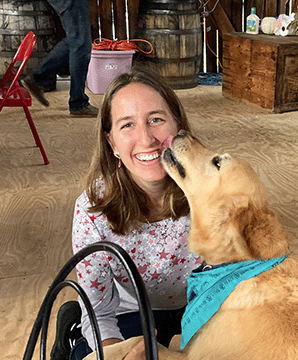 The time and effort invested into barn improvements was spurred by two important events—the wedding of our neighbors on the 18th of September as well as a big shindig birthday bash planned for the 2nd of October. The occasion was my 60th. A group of about 60 people celebrated with a pig roast and folk music band on the 2nd. Equally, we enjoyed a hearty breakfast and worship service the next day in the barn.
The time and effort invested into barn improvements was spurred by two important events—the wedding of our neighbors on the 18th of September as well as a big shindig birthday bash planned for the 2nd of October. The occasion was my 60th. A group of about 60 people celebrated with a pig roast and folk music band on the 2nd. Equally, we enjoyed a hearty breakfast and worship service the next day in the barn.
Seed Collection: Every season and specific climactic condition has its own advantages and disadvantages for pollination and resulting seed production. This year was actually quite good for seed production in Michigan. The many frost events during the second week in May (and some before and after) knocked out some pollination but this year we are collecting many species that are either intermittent in their fruit-set or haven’t successfully fruited lately. On the property we collected copious amounts of White Cedar, Hophornbeam, Red Raspberry and Norway Spruce. At our main farm here in Holland we collected; Hemlock, Black Gum, Black Elderberry, New Jersey Tea, Red Osier Dogwood, Pagoda Dogwood, Yellow Birch, Red Maple, Sugar Maple, Dwarf Bush Honeysuckle, Native Spireas. Most of these are having good to banner years of seed/fruit production.
Fertilization: In August I decided to fertilize differently for 2021. Instead of broadcast application via a 3 point spreader system on the tractor, we did a micro-application system…so instead of more than 3000 lbs of fertilizer applied, we put down about 600#. We applied it by hand and just threw about 2-3 ounces of material (19-19-19) spread out over 3-4 square feet around the base of each tree. This actually went pretty fast. One person can carry 10-15 lbs at a time in a bucket…and while walking, throw one handful near the base of each tree…basically not breaking stride. It took less than 2 days to go over the 15 acres planted. The benefit of this is that we were not feeding the grass and forbs…rather concentrated the benefit on the trees planted. This should be done several times a year but we never quite seem to have enough time early in the early growing season, so we do it when we can.
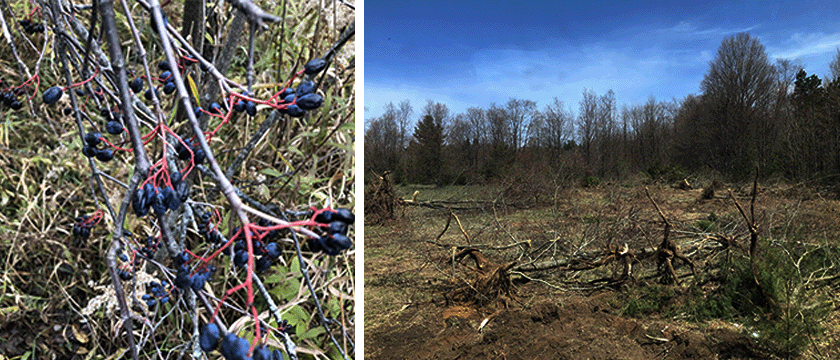
Tree tubes: There was a big wind storm in mid-December in Michigan. Around 1000 of our 7000 tubes blew down with the trees inside during it. Substantial work ensued to right them but happily without substantial damage to the trees as they are flexible enough to bend and not break. What is happening in the 3rd year/summer is that the oak stakes are rotting under the shredded bark. When a strong wind comes they crack off at the rotting point and the weight of the stake pulls the tree over. Of course, this is aided by the plant not being able to produce a strong stem due to that wind-whipping action not being allowed to take place. In the tube there is little movement…and little rigidity is the result. My conclusion from this phenomenon is that really you are better off not buying wood and instead staking with a 6’ fiberglass stake. It won’t rot and it will allow for more wind movement to strengthen the stem of the plant. The fiberglass stake could be put in the tube instead of outside of it and no attachment system (securing the tube to the stake by some means) would be necessary. I’m sure that some tubes could still fly off that way in a very strong wind but not many since the shredded bark exerts pressure on the tube at the bottom of the plant. The second thing we are observing at this point is that many of the taller Black Cherries are in fact strong enough to stay upright now without a stake. We removed zipties from about half of that species this fall, so the breaking stake would in fact not topple the plant. As expected, we will need to go back in and re-ziptie about 5-10% as they’re in fact not ready to stand without the stake…but at least we won’t be re-installing new stakes to the plants that can now hold their own against the wind…but will still benefit from the tubes protection for a few years. All in all, it looks like the tubes will stay on most trees for a total of 6-7 years. This will continue to protect from rodent girdling and from bucks rubbing on their bark.
So, now it’s January 8, the year of our Lord, 2022 as was the standard way of referring to time--not very long ago. We’ve shifted into timber improvement mode again. Covid hasn’t affected us seemingly at all for which we thank Almighty God. Most of our masks are now tucked away and we are largely back to living as usual.
Three of us go up to the property (150 mile drive one way) once every other week for 3-4 days. The process of cutting and trimming continues to improve timber…cutting out inferior plants, felling dead and hung up trees, removing good species with poor form, cutting out less desirable species or just thinning good trees caused by just way too many of them growing together. Our goal is to achieve an eventual spacing of one high quality tree growing on a 20 x 25’ area. That’s a process of course. Once the true “competition” is eliminated, I plan to let the forest floor grow up and improve habitat for birds and mammals. We are also planting in some evergreens, scattered about as an understory…creating a bedding area for the deer, etc.
Rough guess is that if 55% of our property is wooded from before our plantings, that we have made it through maybe half to 60% of that area now, with our attempts to improve the timber.
So, that’s all for now on the updates. I hope you enjoyed it, maybe learned from it and if you want to drop me a line with your comments…just send one to info@alphanurseries.com. I will always appreciate hearing from you!!

|
